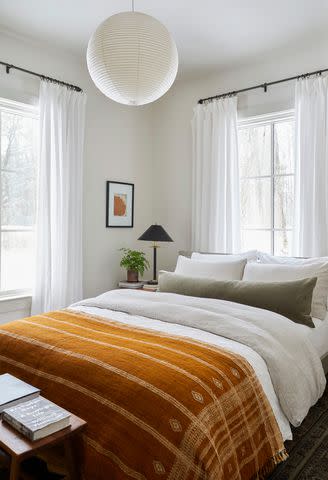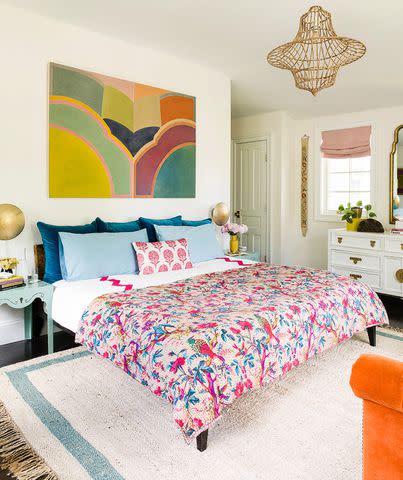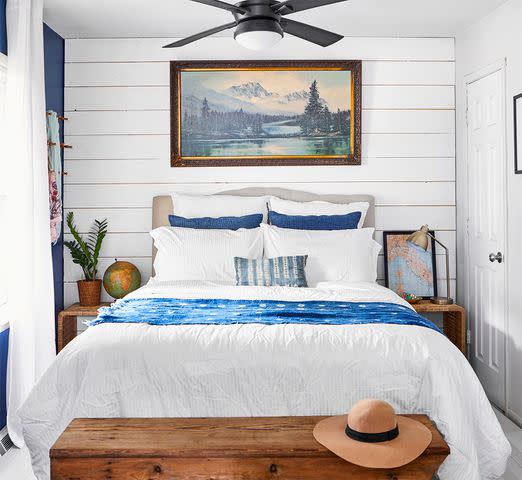How to Buy a Duvet Insert That's the Right Size and Style
Use our ultimate duvet buying guide to find the perfect fit.
A new duvet cover can completely transform the look of your bedroom, but what goes inside is just as important. A duvet insert is a thick, cushy blanket that sits inside a duvet cover. This functional bedding is vital to providing restful sleep—but with so many options for duvet inserts, it can be challenging to pick one that meets your needs.
Duvet inserts come in many different weights, materials, and a wide range of price points. To help you pick the best duvet insert, we've outlined everything you need to consider before purchasing a duvet.
Related: Duvet vs. Comforter: What's the Difference?

But First: Comforters vs. Duvets
When comparing duvets and comforters, duvets outperform comforters regarding design options. Comforters, however, can offer more convenience. Since duvets are neutral (primarily white) blankets that require a cover, they don't offer much style to a bed. When you launder your sheets, you should usually remove the duvet cover to wash it, too. This means undoing each tie, button, or zipper and reattaching afterward. Meanwhile, comforters (a single bedding item) provide warmth and cushion without extra steps.
Since they require covers, a duvet insert never touches your skin. So, unlike bulky comforters, which need frequent washing, you only need to wash a duvet insert once every three to four months.
How to Pick a Duvet Insert
Get the Right Size Duvet Insert
To find the best fit, ensure your duvet insert matches the size of your mattress and duvet cover. If you skip this step, you might end up with portions of your duvet cover slumping off your insert or the insert bunching up inside if it's too big for the cover.
Here are general duvet insert sizing guidelines:
King duvet: 104 inches x 90-94 inches
Queen duvet: 88 inches x 90-94 inches
Twin duvet: 64 inches x 68-88 inches
Related: Your Easy Guide to Buying the Best Mattress for You
Pick a Preferred Weight (Light, Medium, or Heavy)
Like comforters, duvet inserts can be designed to fit a sleeper's temperature preferences, often measured by weight. Thick, heavy inserts will be warmer, while light, thin inserts will be cooler. Medium-weight options are ideal for year-round use. Some brands make duvet inserts for hot sleepers who need to stay cool, like the Lightweight Comforter ($159-$219, Slumber Cloud). Or shop for an extra-heavy insert like the European Down Duvet Insert ($399-$719, West Elm) if you live in a cold climate or prefer extra warmth.

Choose a Duvet Insert Filling
For a soft feel, consider inserts made from silk fibers like this silk-filled thermoregulating all-season duvet ($279-$319, Vesta Sleep). Duvet inserts made from white down and feather (goose and duck), like this Classic Down Duvet Insert ($249-$399, Pottery Barn), are the most popular. But if you want something vegan-friendly or hypoallergenic, you can search for inserts made from a down alternative that still feels plush. Try searching for comforters made from microfiber or cotton clusters instead. For allergy sufferers or those with eczema, you can even buy hypoallergenic inserts filled with wool, such as this wool comforter ($115-$150, Woolroom), which wicks moisture and regulates temperature.
Related: The 6 Best Duvet Inserts of 2023, Based on Testing
Select a Duvet Insert Design
The best duvet inserts are the ones that stay in place and don't slip inside their cover. A common pitfall with poorly designed duvet inserts is their lack of ties. To prevent shifting, look for duvet covers with more than four ties (especially along the sides and corners). If your duvet cover needs extra hold, you can sew loops and ties into it with ribbon or shoelaces ( make sure what you use is machine washable) or buy duvet clips. The thicker the fabric of your duvet cover is, the more plush it will look.
Editor's tip
If you're new to duvets or want to invest wisely, look for brands that offer a 30-,60- or 90-day sleep trial. This way, if your duvet insert doesn't work out for any reason, you can return it.
Look for the Right Shell
Stick to duvet inserts with white shells (the covering that holds the filling), especially if you have white bedsheets. If you pick a colored duvet insert, it might show through a light-colored cover. Also, duvet inserts come in several shell materials, including silk, cotton, organic cotton, polyester, and linen. Remember: the higher the thread count or the more luxurious the material used, the higher the cost.
Related: Should You Pay Attention to Thread Count When Buying Sheets?

Detail Your Budget
Depending on size and quality, a duvet insert can range anywhere from $25 to $5,000. List your non-negotiable bedding elements, like being hypoallergenic or extra warm, to decide how much to spend. Then, look for options that fall in your price range.
You don't need to buy a high-end duvet to reap its benefits, but its quality and features can up the price. As always, it's essential to research each product, read reviews, and compare features between low-, mid-, and high-end duvet options. But know that the material you pick will be the most important factor in its cost. For example, if you go for organic cotton, silk, or a high thread count, expect to pay higher.
Low-quality down duvet inserts could leak feathers faster than high-end ones. The best way to mitigate this is to search for a higher thread count or double-enforced duvet inserts (or stick to a down-alternative filling).
Decide on a Maintenance Level
Cleaning and care instructions should play a role in which insert you pick. If you want something unfussy, look for a duvet you can wash at home (and not pay extra to take to the dry cleaner). Always check the care instructions for your insert before buying. Some inserts require commercial-size machine washing, while others are dry-clean only. The most convenient option will be based on your lifestyle and needs.
Duvet Cover Options
Once you've chosen your insert, you'll want to pick out a duvet cover in a design and color that works with your bedroom style. There are countless patterns, colors, and materials, so you can quickly refresh your bedding, whether you need a seasonal update or a style change. With duvets, swapping out a cotton spring-inspired design for a flannel plaid option during the holidays is simple.
Learning how to put a duvet cover on an insert can be frustrating. Our guide to this process will make it easier.
Related: The 8 Best Duvet Covers of 2023 for Style and Comfort, According to Testing
For more Better Homes & Gardens news, make sure to sign up for our newsletter!
Read the original article on Better Homes & Gardens.
